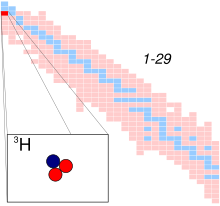
Back Tritium Afrikaans تريتيوم Arabic تريسيوم ARY Tritiu AST Tritium Azerbaijani Tritium BAN Трытый Byelorussian Трыт BE-X-OLD Тритий Bulgarian ট্রিটিয়াম Bengali/Bangla
 | |
| General | |
|---|---|
| Symbol | 3H |
| Names | tritium, 3H, H-3, hydrogen-3, T, 3T |
| Protons (Z) | 1 |
| Neutrons (N) | 2 |
| Nuclide data | |
| Natural abundance | 10−18 in hydrogen[1] |
| Half-life (t1/2) | 12.32 years |
| Isotope mass | 3.01604928 Da |
| Spin | 1/2 |
| Excess energy | 14949.794±0.001 keV |
| Binding energy | 8481.7963±0.0009 keV |
| Decay products | 3He |
| Decay modes | |
| Decay mode | Decay energy (MeV) |
| Beta emission | 0.018590 |
| Isotopes of hydrogen Complete table of nuclides | |
Tritium (from Ancient Greek τρίτος (trítos) 'third') or hydrogen-3 (symbol T or 3H) is a rare and radioactive isotope of hydrogen with half-life ~12.3 years. The nucleus of tritium (t, sometimes called a triton) contains one proton and two neutrons, whereas the nucleus of the common isotope hydrogen-1 (protium) contains one proton and zero neutrons, and that of a non-radioactive hydrogen-2 (deuterium) contains one proton and one neutron.
Naturally occurring tritium is extremely rare on Earth. The atmosphere has only trace amounts, formed by the interaction of its gases with cosmic rays. It can be produced artificially by irradiation of lithium metal or lithium-bearing ceramic pebbles in a nuclear reactor and is a low-abundance byproduct in normal operations of nuclear reactors.
Tritium is used as the energy source in radioluminescent lights for watches, night sights for firearms, numerous instruments and tools, and even novelty items such as self-illuminating key chains. It is used in a medical and scientific setting as a radioactive tracer. Tritium is also used as a nuclear fusion fuel, along with more abundant deuterium, in tokamak reactors and in hydrogen bombs.